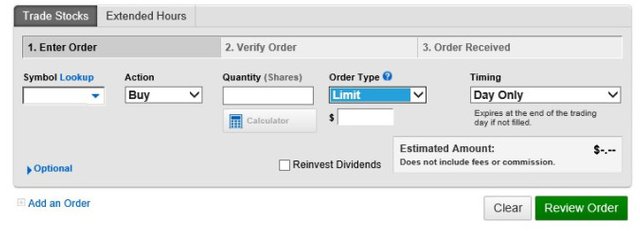Executing a Trade with Limit Orders – A Must
Assuming you’ve setup your own brokerage account, have identified an position to enter, and are ready to execute, you are likely wondering, “How exactly do I enter the trade?”
Use a limit order, that’s how.
A limit order is a way for us to detail the exact amount we are willing to pay when entering a position. I ALWAYS execute my trades via limit orders, in contrast to the more common market order.
Why?
Market orders leave us exposed to the market makers who define what the spread (difference) is between the bid price and the asking price. Depending on the size of the spread between bid and asking price, the market maker can really take advantage of us. Screw that, we prefer to define our own bid value, thank you very much.
This is something that most folks do not understand. Yet, each time they enter a market order trade they are losing pennies on the dollar to an unknown market maker. That adds up quickly if we’re frequently entering trades worth more than $100, and odds are we are.
Ever hit the refresh button continuously on the price of a specific stock, and watch as it fluctuates each second? Well, when we enter a market order the seller gets to decide at what price he will sell to us. Unfortunately, they are much more sophisticated than us retail investors (and they are positioned to profit, as are we) so you can bet your ass they are going to sell to us at the higher price.
Would we not do the same thing if we were in their position? Of course we would, it’s only natural!
Market makers are usually only skimming pennies from us, but depending on our order size and order frequency, this skimming loss could become a considerable fee. And it happens on both sides of the transaction: when we enter a trade, and then when we exit too.
Entering/exiting a position with a limit order eliminates this exposure to pricing spread manipulation. With a limit order, we are explicitly defining what we are willing to pay to our broker. They have to execute the trade within these parameters, no way around it.
Each trading platform has a somewhat unique interface, but they all generally function the same. Here is what entering a trade via a limit order looks like on Charles Schwab:

Notice how I define a “Buy” action and “Limit” as the order type. Now, I only need to define the stock I want to purchase, as well as the price I am willing to pay for it. I must also define what time frame I am willing to keep this purchase order open (I prefer “Good Until Cancelled”). When I go to exit a position all of the input will be the same, but the action will be “Sell”.
Here is what a limit order looks like on GDAX:
I will analyze how to determine a fair price to pay further in a future post, but for now just remember:
A strategically placed limit order will allow you to enter a trade at a discount to your unwitting compatriots ordering with market orders.
“They say ignorance is bliss…. they’re wrong ” ― Franz Kafka